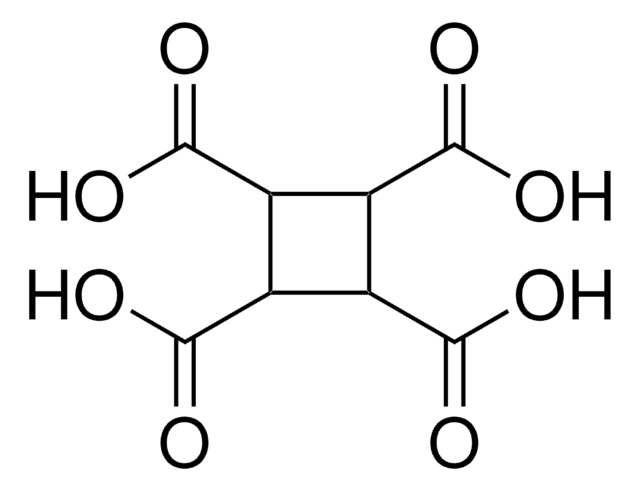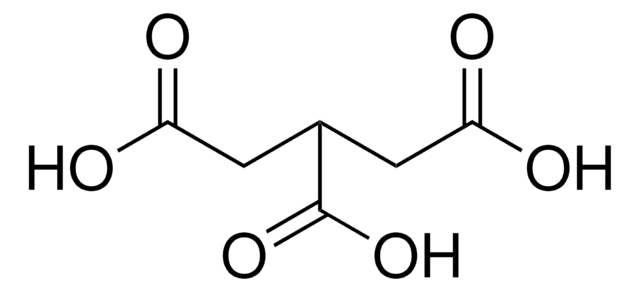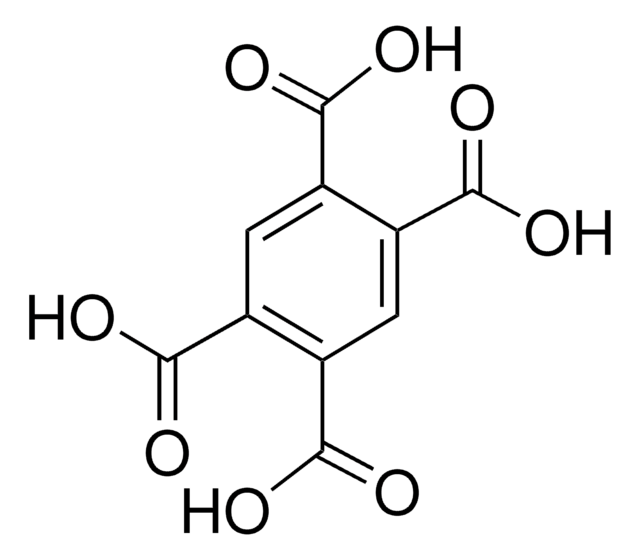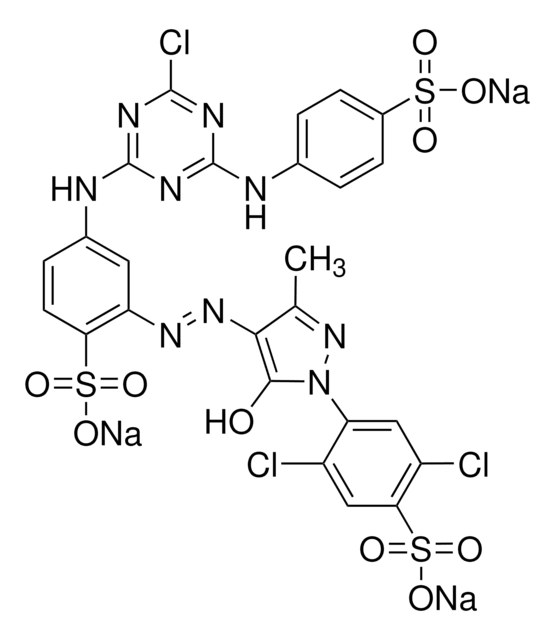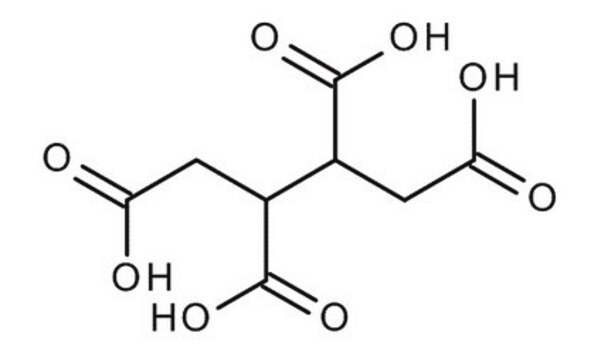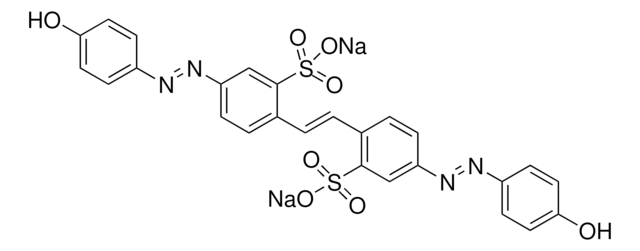Wszystkie zdjęcia(3)
Kluczowe dokumenty
257303
1,2,3,4-Butanetetracarboxylic acid
99%
Zaloguj sięWyświetlanie cen organizacyjnych i kontraktowych
About This Item
Wzór liniowy:
[-CH(CO2H)CH2CO2H]2
Numer CAS:
Masa cząsteczkowa:
234.16
Beilstein:
1729167
Numer WE:
Numer MDL:
Kod UNSPSC:
12162002
Identyfikator substancji w PubChem:
NACRES:
NA.23
Polecane produkty
Poziom jakości
Próba
99%
Formularz
powder
mp
195-197 °C (dec.) (lit.)
ciąg SMILES
OC(=O)CC(C(CC(O)=O)C(O)=O)C(O)=O
InChI
1S/C8H10O8/c9-5(10)1-3(7(13)14)4(8(15)16)2-6(11)12/h3-4H,1-2H2,(H,9,10)(H,11,12)(H,13,14)(H,15,16)
Klucz InChI
GGAUUQHSCNMCAU-UHFFFAOYSA-N
Szukasz podobnych produktów? Odwiedź Przewodnik dotyczący porównywania produktów
Powiązane kategorie
Opis ogólny
1,2,3,4-Butanetetracarboxylic acid (BTCA) is utilized as a cross-linking agent and as a building block for the synthesis of specialized polymers for the formulation of resins, polymers, coatings, and adhesives.
Zastosowanie
1,2,3,4-Butanetetracarboxylic acid (BTCA) can be used as a cross-linking agent:
- To functionalize cotton fabric. BTCA-treated fabric shows improved anti-pilling, wrinkle resistance, and fire-retardant properties.
- To fabricate flexible, free-standing nanocellulose membranes. The cross-linking with BTCA improves water stability and ionic conductivity of membranes.
Ta strona może zawierać tekst przetłumaczony maszynowo.
Hasło ostrzegawcze
Warning
Zwroty wskazujące rodzaj zagrożenia
Zwroty wskazujące środki ostrożności
Klasyfikacja zagrożeń
Acute Tox. 4 Oral - Eye Irrit. 2
Kod klasy składowania
11 - Combustible Solids
Klasa zagrożenia wodnego (WGK)
WGK 3
Temperatura zapłonu (°F)
Not applicable
Temperatura zapłonu (°C)
Not applicable
Środki ochrony indywidualnej
dust mask type N95 (US), Eyeshields, Gloves
Wybierz jedną z najnowszych wersji:
Masz już ten produkt?
Dokumenty związane z niedawno zakupionymi produktami zostały zamieszczone w Bibliotece dokumentów.
Mattia Alberto Lucchini et al.
ACS applied materials & interfaces, 10(35), 29599-29607 (2018-08-08)
In this work, we report a versatile approach for the development of an in-flow purification water system under solar illumination. Cellulose nanofibrils (CNFs) were impregnated with TiO2 nanoparticles using water as a solvent to obtain hybrid CNF/TiO2 monoliths with 98%
Limin Guo et al.
Carbohydrate polymers, 179, 333-340 (2017-11-08)
Cellulose nanofibril (CNF) aerogel is highly flammable and its mechanical strength is very soft, which is unfavourable due to safety concerns and impractical when used as the thermal insulation material. In this work, we used N-methylol dimethylphosphonopropionamide (MDPA) and 1,2,3,4-butanetetracarboxylic
Solmaz Heydarifard et al.
Carbohydrate polymers, 181, 1086-1092 (2017-12-20)
Development of a foam-formed cellulose filter paper with high wet strength was carried out for application as a drinking water filter. The wet strength and antimicrobial activity of cellulose foam paper against several bacteria species (Bacillus subtilis MTCC 441 (Gram
Asli Celebioglu et al.
Scientific reports, 7(1), 7369-7369 (2017-08-09)
Water pollution is a serious concern for public health and environment in today's world; hence, there exists a strong demand to develop cost-effective, sustainable and eco-friendly membranes. Here, we produce a highly efficient molecular filter membrane based on bio-renewable material;
Peipei Wang et al.
Carbohydrate polymers, 218, 103-111 (2019-06-22)
Environmentally friendly, sustainable, and high-performance thermal insulators are in high demand. Petroleum-based insulator foams usually have high thermal conductivity and pose health hazards. Here, we report ultralight composite foams that are highly strong, elastic, and super-insulating. The foams are composed
Global Trade Item Number
| SKU | GTIN |
|---|---|
| 257303-5G | |
| 257303-500G | 4061833595923 |
| 257303-100G | 4061826059272 |
Nasz zespół naukowców ma doświadczenie we wszystkich obszarach badań, w tym w naukach przyrodniczych, materiałoznawstwie, syntezie chemicznej, chromatografii, analityce i wielu innych dziedzinach.
Skontaktuj się z zespołem ds. pomocy technicznej